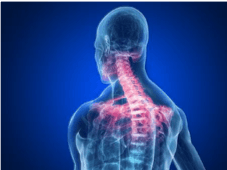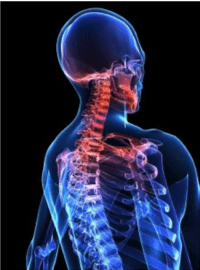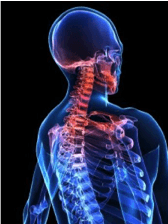Neck Pain Treatments
CERVICAL MYELOPATHY
Inflamed neck
 Cervical myelopathy occurs when there is pressure on or damage to the spinal cord itself. Cervical spondylosis is a common cause of this condition, as the wear and tear to the vertebra can narrow the canal through which the spinal cord runs.
Cervical myelopathy occurs when there is pressure on or damage to the spinal cord itself. Cervical spondylosis is a common cause of this condition, as the wear and tear to the vertebra can narrow the canal through which the spinal cord runs.
Prolapse of a cervical disc can also cause myelopathy if the disc prolapse is into the central canal of the vertebra. Although it is very rare for either a tumour or infection to be the cause, a medical opinion and MRI is very important to have. As the nerve fibres run from the brain to the extremities, there can be many symptoms of cervical myelopathy, including:
- Difficulty with walking, legs feel clumsy and stiff
- Clumsy hands, dropping things
- Difficulty with easily emptying your bladder
Quick Contact
Diagnosis for this is by MRI and neuro consultant, and for treatment options, see a neurologist for advice.
CERVICAL RADICULOPATHY
Do you have pain and numbness in your arms and/or hands?
If symptoms of pain, pins and needles, numbness, and weakness can be felt anywhere from your shoulder to your fingers, you may be told you have cervical radiculopathy (nerve pain down the arm). This provisional diagnosis can be given by a spinal specialist physiotherapist or your chosen physical therapist such as a chiropractor or osteopath.
Radiculopathy is the irritation of the nerve roots at the spinal cord, sufficient enough to cause pain, pins and needles, or weakness across the shoulder and down the arm to the fingers. Radiculopathy can be caused by wear and tear, disc herniation, muscle spasm, or osteophyte growth.
It usually gradually resolves over a few weeks, and the treatment that I would give would be spinal specialist physiotherapy, including modalities such as Acupuncture, Gunn IMS dry needling, laser, soft tissue work, gentle facet joint mobilisations, postural advice, and gentle exercise to progressively strengthen the muscles. The GP can also offer meds to help you through the worst of the pain.
If your symptoms don’t improve, your therapist will refer you back to your GP. In more severe cases, where your hands feel clumsy, you have problems with walking, or problems with bladder function start occurring, this may be due to pressure from a worn vertebra or disc damaging the spinal cord, which is cervical myelopathy. A spinal surgeon will check this out with the aid of MRI scans.
Book to see your GP urgently if:
- The pain gets much worse.
- There is a worsening (numbness), weakness, or you have persistent pins and needles in part of an arm or hand.
- You develop any problems with walking or with passing urine. These symptoms suggest that cervical myelopathy may be developing as a complication of the cervical radiculopathy.
- You develop dizziness or blackouts when turning your head or bending your neck. This can suggest that the vertebral artery – which supplies the brain – is being nipped by the degenerative changes in the spine. This gets more common as we age.
Both cervical radiculopathy and myelopathy can develop from spondylosis (disc wear and tear).
CERVICAL SPONDYLOSIS

The neck (cervical spine) has seven vertebrae. The top two allow the neck to pivot sideways, and the next five are barrel-shaped, linking to each other at tiny bevelled (facet) joints and cushioned by discs. These discs are tough fibrous structures with a gel-like middle.
Do you have recent stiffness in your neck with mild pain spreading out to your upper back and shoulders?
If so, you may have osteoarthritis and/or cervical spondylosis.
OSTEOARTHRITIS
Osteoarthritis (OA) – the most common type of arthritis – is wear and tear in the smooth cartilage that protects the bones in joints, eventually leading to bone erosion, bone spurs, and unsightly bony end thickening. The joint juice – the synovial fluid – swells and becomes inflamed and sticky, and the attacked bone haemorrhages precious calcium. By the time we are 50 years old, 8 out of 10 of us have OA, and by 60, this goes up to 9 out of 10. Left untreated, OA can have a massive negative impact on quality of life and will eventually need surgery.
Provisional diagnosis is by a physical assessment with a physiotherapist, a GP with specialist interests in arthritis, an osteopath, chiropractor, rheumatologist, or orthopaedic surgeon. Then, you will need confirmation with bloods and X-ray, or MRI.
Personally, my favourite treatment modalities that I use include: physiotherapy-prescribed exercises, electro-acupuncture to give some immediate pain relief with TENS, ultrasound, laser and pulsed shortwave, Gunn IMS assessment for any neuropathic pain overtures, and in less severe cases, shockwave for joint stiffness.
In order to firefight the pain, we can use GP prescribed medicines, then a long-term nutritional assessment from a nutritional expert with advice on food and supplements.
WHIPLASH

Whiplash is a relatively common injury that occurs to a person’s neck following a sudden acceleration-deceleration force, most commonly from motor vehicle accidents. The term ‘whiplash injury’ describes damage to the vertebrae and soft tissues, while the term ‘whiplash associated disorder’ describes a more severe and chronic condition.
Fortunately, whiplash is typically not a life-threatening injury, but it can lead to a prolonged period of partial disability. My neck ached for many weeks after a car took out my father’s car one dark, wet night in Lincolnshire – I was a sleeping passenger.
While most people involved in minor motor vehicle accidents recover quickly without any chronic symptoms, some continue to experience symptoms for years after the injury. If you fall into this category, Gunn IMS pain clinics may well be the answer.
So what causes whiplash?
Whiplash is most commonly caused by a stationary car being impacted by another from behind, without notice. It is commonly thought that the rear impact causes the head and neck to be forced into hyperextension, and especially the lower part of the neck, as the seat pushes the trunk forward – and therefore the unrestrained head and neck fall backwards. After a short delay, the head and neck then recover and are thrown into a hyper-flexed position.
More recent studies (investigating the condition using high-speed cameras and crash dummies), have shown that after the rear impact, the lower cervical vertebrae forcibly hyperextend, while the upper cervical vertebrae are hyper-flexed. This leads to an abnormal S-shape motion in the cervical spine, and causes damage to the soft tissues between the cervical vertebrae.
My favourite treatment options for acute (recent) whiplash include: physiotherapy, massage, facet joint mobilisations, ultrasound, pulsed shortwave, laser, and gentle Acupuncture. If non-resolving or chronic (long-term), try Gunn IMS, postural and exercise advice, stronger massage, and a counselling healing approach.
TORTICOLLIS (WRY NECK)
 With this, the top of the head generally tilts to one side while the chin tilts to the other side.
With this, the top of the head generally tilts to one side while the chin tilts to the other side.
Torticollis may be:
- Inherited: Due to specific changes in your genes.
- Acquired: It develops as a result of damage to the nervous system or muscles.
If there is no known cause, it is called idiopathic torticollis. Torticollis may develop in childhood or adulthood.
Provisional diagnosis is done by a physiotherapy assessment.
TEMPORARY TORTICOLLIS
This type of wry neck usually disappears after one or two days, and it can be due to:
- Swollen lymph nodes.
- An ear infection.
- A cold.
- An injury to your head and neck that causes swelling.
Congenital torticollis (present at birth) may occur if the foetal blood supply or muscle development was injured or if the foetus’ head is in the wrong position while growing in the womb.
FIXED TORTICOLLIS
Fixed torticollis is also called acute torticollis or permanent torticollis, and it usually occurs due to a problem with the muscular or bony structure.
MUSCULAR TORTICOLLIS
This is the most common type of fixed torticollis, and it results from scar-ring or tight muscles on one side of the neck.
KLIPPEL-FEIL SYNDROME
This is a rare, congenital form of wry neck, and it occurs when the bones in your baby’s neck form incorrectly, notably due to two neck vertebrae being fused together. Children born with this condition may have difficulty with hearing and vision.
CERVICAL DYSTONIA
This rare disorder is sometimes referred to as spasmodic torticollis, as it causes the neck muscles to contract in spasms. If you have cervical dys-tonia, your head twists or turns painfully to one side, and it may also tilt forward or backward. Cervical dystonia sometimes goes away even without treatment. However, there is a risk of recurrence.
My favourite treatment options for mild cases of wry neck include: physio-therapy, gentle manual traction, mobilisations, Acupuncture, massage, and warmth. If severe, however, it may need a neurologist referral for injections, strong meds, or even surgery. A very useful test is an electromyogram (EMG), which measures electrical activity in your muscles. It can also determine which muscles are affected.
Imaging tests such as X-rays and MRI scans can also be used to find structural problems that might be causing your symptoms.
Your doctor may recommend surgery, such as:
- Fusing abnormal vertebrae.
- Lengthening neck muscles.
- Cutting nerves or muscles.
- Deep brain stimulation to interrupt nerve signals, which is used only in the most severe cases of cervical dystonia
Medications can also be helpful, and they can include:
- Muscle relaxants.
- Medications used to treat the tremors of Parkinson’s disease.
- Botulinum toxin injections, repeated every few months.
- Pain medications.
OSTEOARTHRITIS AND FACET JOINT LOCK
 Facet joints in the neck (cervical) and lower back (lumbar) can become locked due to muscles going into spasm or a fold occurring in the joint meniscus. This can be caused by a movement or injury that has either happened recently or some time before, and movement will be restricted depending on the position the joint was locked in. To gain a range of motion, other joints near the lock will tend to be excessively moved and so pain will ensue near the lock or sometimes on the opposite side. If
Facet joints in the neck (cervical) and lower back (lumbar) can become locked due to muscles going into spasm or a fold occurring in the joint meniscus. This can be caused by a movement or injury that has either happened recently or some time before, and movement will be restricted depending on the position the joint was locked in. To gain a range of motion, other joints near the lock will tend to be excessively moved and so pain will ensue near the lock or sometimes on the opposite side. If
a facet joint in the neck is locked, it can cause symptoms in the neck and into the arms, and a lumbar facet joint lock can cause sciatica symptoms. A lack of core stability muscle control is a prime cause of lumbar facet joint lock.
Provisional diagnosis is by physiotherapy assessment, and treatment options to reduce the pain, inflammation, stiffness, and weakness include: physiotherapy, chiropractic or osteopathic mobilisations, manipulation, core stability, specific spinal rehabilitation exercises, posture advice, laser, Acupuncture, Gunn IMS dry needling, shockwave, pulsed shortwave, massage, nutrition, and counselling.